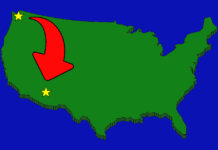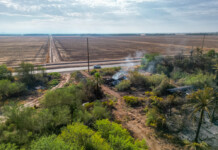
Emerson Oliver Stratton was born in New York in 1846 and moved to Arizona in 1875. He was a clerk and bookkeeper at Maricopa Wells at one time and wrote about his first encounter with the Wells in his journal, “Reminiscences of E. O. Stratton.”
He said it was in the fall of 1875 that he left his job as a house builder in California and moved to Arizona to make his fortune. He had heard of a wonderful gold discovery in the Graham Mountains in Arizona from H. C. Hooker. Hooker was one of the largest cattle owners in Arizona at that time.
Henry Clay Hooker got his start in the cattle business with the purchase of 500 turkeys he bought for a $150, herded them across the Sierras where he sold them in Carson City, Nevada to the miners for $5 apiece. While herding them through the Sierras, he thought for sure his money had gone down the drain when they were spooked and flew into the air and over a steep cliff. When he arrived at the bottom of the mountain, he found them patiently waiting for him. However, it was cattle, and not turkeys, that Hooker had in mind when he sold the turkey to the miners. He used the capital to purchase cattle and kept the military posts and Indian agencies in Arizona supplied from 1967 to 1870. Then he bought what would become an 800-acre ranch in the southeastern part of Arizona, Sulphur Spring Valley, and built his Sierra Bonita Ranch that eventually became the largest and one of the most important ranches in Arizona.
On the way to Arizona Stratton met a man called James Barney who told him about a job at Maricopa Wells with James A. Moore. Moore had the Tucson to Yuma division of the Overland Stage Company mail contract and needed a clerk and bookkeeper. Stratton signed a contract to stay and work for six months at the wells. Moore had trouble hiring and keeping employees. Some came “just for the ride” and disappeared into the desert to look for gold, and others soon lost heart because the work was tedious, boring and involved much-dreaded government red tape and complicated reports. Or they left because of the loneliness of such an isolated place, or feared the vast and strange barren country.
Stratton said he left San Diego in a four-horse “Mud Wagon” stage. It was called that because it was lighter than the other wagons. It had only two seats and could accommodate five passengers instead of sixteen as the larger stages did. The coach was canvas-covered with a seat outside for the driver and two seats inside facing each other.
Most stations were located within 20 miles of one another. The horses trotted or ran the whole 20 miles to the next relay station where fresh teams were hitched up and ready to run the next stretch. Stratton complained that it was a long, hard and tiresome trip.
Stratton described Maricopa Station, “Though small, Maricopa Wells was a busy place. The stages passing twice a day, one eastbound and one westbound, changed animals and fed their passengers here. When troops were discharged – and this was often – the stages were full both ways. At other times there was a predominance of passengers from the West. Not only were many Californians coming into the country, but there also were the Easterners who had gone by train or around the Horn to San Francisco, then came down the coast to San Diego and into Arizona by stage. Then, too, Maricopa Wells was the division point for Phoenix, Fort McDowell on the Verde and other places to the north.
The camping ground outside the enclosure was also a busy place. Great freight trains of three or four wagons and eight to 20 mules were often camped there; and detachments of soldiers – from a few scouts to one or more companies – might turn in for the night. Soldiers scouting through the immediate country usually made Maricopa Wells their supply station; and all westbound traffic, whether or not they camped, had to load up with enough water to last across the desert from Maricopa to Gila Bend, a distance of 45 miles which meant at least one night’s camp.”
The population at Maricopa Wells included Moore, his wife Jane, son Arthur, twin daughters Susan and Clara, and a stepson, John Crampton. The Wells housed several other people who were employees or rented rooms. There was a telegraph operator for the government line, and a telegraph line rider who was also a soldier. One employee was a teamster who hauled supplies and other goods for the station. The hostler was in charge of the stage horses, and the blacksmith not only took care of the stage horses, but also hired out to do blacksmith work such as shoeing and wagon repairing. There was a cook, a roustabout, and a herder who lived and worked at the Wells. The herder was also a butcher for the compound and ran about 50 head of cattle that supplied meat for the restaurant and store.
One day a farmer from Peeples Valley, which is near Prescott, came to the Wells and asked about a favorite food he had heard about called, “macaroni.” He wanted to buy all the macaroni the store had. At that time, macaroni, sold by the bulk, came in wooden boxes that weighed about 10 pounds each. The store had several of these boxes. Stratton was curious as to why this farmer wanted so much macaroni. The farmer said that almost anything could grow on his ranch, and he wanted to experiment with macaroni to see if it would grow there, too. It took a lot of talking to convince this man that one did not grow “macaroni.”
Stratton’s contract stated that his term of employment was for six months, but Moore had difficulty finding a replacement for him. Stratton had worked hard at the Wells and had learned much, but he was anxious to follow his dream of prospecting in Arizona. He said all during his stay at Maricopa, he was mine crazy and longed to pursue this dream. However, it would be another two months before he was free to seek his fortune in the hills of Arizona. After he left Maricopa Wells, Stratton operated the Stratton Mines near Mount Lemmon.
Editor’s note: Maricopa factoids are a regular feature on InMaricopa.com. They are provided by the Maricopa Historical Society, a branch of the Friends of the Maricopa Public Library. Most of the photos and information come from “Reflections of a Desert Town” by author and historical society chairperson Patricia Brock.

![Rizz party organizers say city ‘lying’ One of several flyers for a "TikTok rizz party" is taped to a door in the Maricopa Business Center along Honeycutt Road on April 23, 2024. [Monica D. Spencer]](https://www.inmaricopa.com/wp-content/uploads/2024/04/spencer-042324-tiktok-rizz-party-flyer-web-218x150.jpg)
![Province writer opens the athlete’s mind in new book Tom Schuman, a Province resident, poses with a copy of his new book, "My Wide World of Sports," outside his home on May 2, 2024. [Monica D. Spencer]](https://www.inmaricopa.com/wp-content/uploads/2024/05/spencer-050224-tom-schuman-sports-book-web-01-218x150.jpg)








![Maricopa restaurateur makes Food Network connection [Namkeen Dhaba]](https://www.inmaricopa.com/wp-content/uploads/2024/04/439456716_377105198650519_7536248579664805896_n-218x150.jpg)
![Merging lanes incite more 347 anger A merging lane sign sits on the side of State Route 347 northbound lanes during evening traffic on April 30, 2024. [Monica D. Spencer]](https://www.inmaricopa.com/wp-content/uploads/2024/04/spencer-043024-adot-merging-lanes-347-web-218x150.jpg)



![Rizz party organizers say city ‘lying’ One of several flyers for a "TikTok rizz party" is taped to a door in the Maricopa Business Center along Honeycutt Road on April 23, 2024. [Monica D. Spencer]](https://www.inmaricopa.com/wp-content/uploads/2024/04/spencer-042324-tiktok-rizz-party-flyer-web-100x70.jpg)